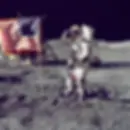Leaving Low Earth Orbit: A Whistlestop Tour of the Infamous Space Race
- Sent Into Space
- May 1
- 4 min read

Manned spaceflight stands as one of the true pinnacles of human ingenuity – especially considering how rapidly the associated technologies were developed – and it’s astonishing to think that only 12 years elapsed between the first man-made object entering orbit and humans setting foot on the moon.
Of course, much of this can be attributed to the ideological battle between communism and capitalism, with Russia and the United States vying for dominance in the air and beyond as the Cold War heated up.
Unfortunately, this remarkable pace turned out to be completely unsustainable once the conflict began to wane, with the public enthusiasm needed to justify such expensive space programs drastically dwindling by the early 1970s. Rather than kicking off a glorious age of manned space travel, like many expected, the moon landings instead sounded a death knell for human travel beyond the confines of low Earth orbit.
The Space Race Begins: Escaping the atmosphere

The starting gun for the Space Race was fired on October 4, 1957, when the Soviet Union launched the world’s first artificial satellite Sputnik 1. This maiden orbital insertion took the entire world by surprise and demonstrated in dramatic fashion the nation’s ability to launch objects (whether innocuous or nefarious) beyond the confines of the Earth’s atmosphere. The US was understandably alarmed and, fearing the threat of Russian long-range nuclear warheads, quickly ramped up its own spaceborne ambitions.
However, before the US could even respond, the Soviets made history yet again by launching the first animal into orbit (a dog named Laika) aboard Sputnik 2. Though no provisions were made to recover the test subject – meaning the poor pup didn’t survive the trip – the flight successfully demonstrated the feasibility of sending living beings into space.
The US launched its first satellite Explorer 1 just a couple of months later which, along with the founding of the National Aeronautics and Space Administration (NASA), effectively signalled the beginning of the American space program. By early 1961, the US had gained some serious momentum and succeeded in putting the first chimpanzee in space, further paving the way for human spaceflight.
By now, the race to send the first human into space was in full swing, reaching a dramatic crescendo in 1961 when Soviet cosmonaut Yuri Gagarin became the first person to travel into space. On April 12, Gagarin completed an orbit of the Earth in a mission lasting 108 minutes in total, solidifying the Soviet Union's dominance in space.
Not to be outdone, NASA followed suit later that year by launching Alan Shepard into space on a 15-minute suborbital flight, with John Glenn becoming the first American to successfully orbit the Earth less than a year later.
Leaving Low Earth Orbit: Lunar ambitions

While the early years of the Space Race focused mainly on satellite technology and manned orbital crafts, its pièce de résistance began to unfold in the early 1960s as the US and Soviet Union both set their sights on lunar landings. In 1961, President John F. Kennedy famously set the ambitious target of landing an American on the Moon by the end of the decade, leading directly to the birth of the Apollo programme.
As the swinging sixties wore on, the US began development of its Saturn V rocket, a launch platform designed specifically to carry astronauts to the Moon. Finally, on July 20, 1969, the US made history by successfully landing Neil Armstrong and Buzz Aldrin on the lunar surface, with Armstrong’s famous words echoing around the world and marking a defining moment in human history. This success cemented America’s position as the global leader of space exploration, with the Soviet Union unable to match its monumental achievements.
Ending not with a bang but a whimper

While the Moon landings were rightly hailed as one of humanity’s crowning achievements, the momentum powering the Space Race soon began to stall. As public fascination waned and political priorities shifted, the immense financial burden of deep space exploration became ever harder to justify. By the mid-1970s, with the Apollo program quietly winding down, it became clear that the golden age of manned exploration was truly coming to an end.
In the decades that followed, space agencies focussed on low Earth orbit as a destination for crewed spaceflights – culminating in long-term projects such as Skylab, Mir and the International Space Station – and it was left solely to robotic scouts (like the Voyager probes and Mars rovers) to fly the flag for mankind’s exploration of the wider solar system.
Today's Private Space Race
Since the Apollo programme drew to a close in the early 1970s, the idea of sending humans beyond low Earth orbit has largely been relegated to the realms of science fiction. However, in recent years, the tide appears to finally be turning. With renewed interest from national space agencies, as well as a growing number of private companies throwing their hats into the ring, serious plans are once again being made to revisit the Moon – and perhaps even Mars. It remains to be seen whether these ambitions will actually materialise, but for now there’s now a genuine sense that human spaceflight could be ready to break free from low Earth orbit once again.

.png)